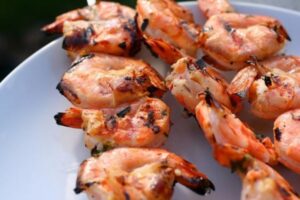Your Guide to Eating Sustainable Shrimp

Shrimp is the number one seafood eaten in America. Even non-seafood lovers eat shrimp: shrimp cocktail, shrimp kebabs, shrimp dip, shrimp scampi… it’s a delicious little treat. Unfortunately, it’s also an unsustainable one. From devastating ocean life to degrading mangrove habitats and local communities, the shrimp business can be a nasty one. You don’t have to give it up, completely, though. Just as there are better burgers, better potatoes, and better corn options out there, you can also find better shrimp choices. Read on for your guide to finding sustainable shrimp.
First, let’s go through the types of shrimp you may want to avoid: imported farmed shrimp and imported wild shrimp.
The Problem with Imported Farmed Shrimp
About 90% of the shrimp we consume here is imported farmed shrimp, usually coming from Asia and South America. By and large, these overseas shrimp farms lead to incredible destruction of local communities and ecosystems. Coastal areas and lush mangroves are wiped clean to raise massive amounts of shrimp, but because of a lack of management or environmental law, these waters become polluted within a matter of just a few years. So polluted, in fact, that often the wildlife dies off, and even the shrimp cannot be raised there anymore. The whole farm is picked up, transported down the line to the next coastal or mangrove area, and the process continues. This process has continued for years for much of the shrimp farming business, and it’s led to an incredible loss of biodiversity and habitat (as well as the loss of a local economy for the natives in those areas).
The Problem with Imported Wild Shrimp
The other type of shrimp that sends red flags is imported wild shrimp. Wild shrimp is caught in the ocean, often using massively large, heavy nets called trawls. Trawls are weighted down to hit the bottom of the sea floor (where the shrimp hang out), and they are incredibly efficient at catching anything in their paths—not only shrimp, but any other animals down there, along with coral reef. The amount of fish and wildlife accidentally caught in these nets is called “bycatch,” and it’s estimated that for every single pound of shrimp caught, from three to 15 pounds of other life is accidentally caught. That bycatch isn’t eaten for dinner, either. It’s thrown away or left dying in the ocean, as law typically prevents fishermen from keeping those miscellaneous items. Imported wild shrimp caught using these trawl nets has led to an enormous loss of animal life in our oceans, and a terribly large loss of coral reef, which is a critical habitat for the balance of the ocean ecosystem.
It’s easy to feel defeated in the great shrimp debate. But there actually are some really great options out there. And it may not surprise you to learn, many of them are found locally.
There Are Better Options
In general, wild-caught shrimp from the United States are either a good or great choice, depending on the waters they came from. Those tiny little pink shrimp from the Pacific Coast are a great choice, very sustainably harvested with small nets and traps in local waters. Freshwater prawns and wild shrimp from the Atlantic Coast or Southern parts of the US are also good choices.
And locally farmed shrimp also tend to be good or great choices. Also from the West Coast, farmed shrimp are a very sustainable choice. They are raised in systems called “fully recirculating,” which means their water is funneled in a closed system so that it doesn’t reach nearby local waters, and it’s cleaned and filtered on site. There are similar shrimp farms in the rest of the country, especially in the Midwestern and Southern states.
Finding the Good Stuff
It’s not impossible to find sustainable shrimp options, either. They’re just probably not at the fish counter of Von’s or Jewel-Osco (you may be surprised, though!). Try local co-ops, health food stores, specialty markets or local seafood suppliers. And just ask:
- Where is this shrimp from? (US and surrounding waters are a better choice)
- Is this wild or farmed?
- If wild, are these caught with large bottom trawls, or with small traps?
- If farmed, are they farms with fully recirculating systems?
And look for sustainable certifications on the label of your shrimp if buying at a market. Some great certifications include:
- Marine Stewardship Council (or the MSC)
- Wild American Shrimp
- Green-listing from Monterey Bay Aquarium
Image: mccun934

